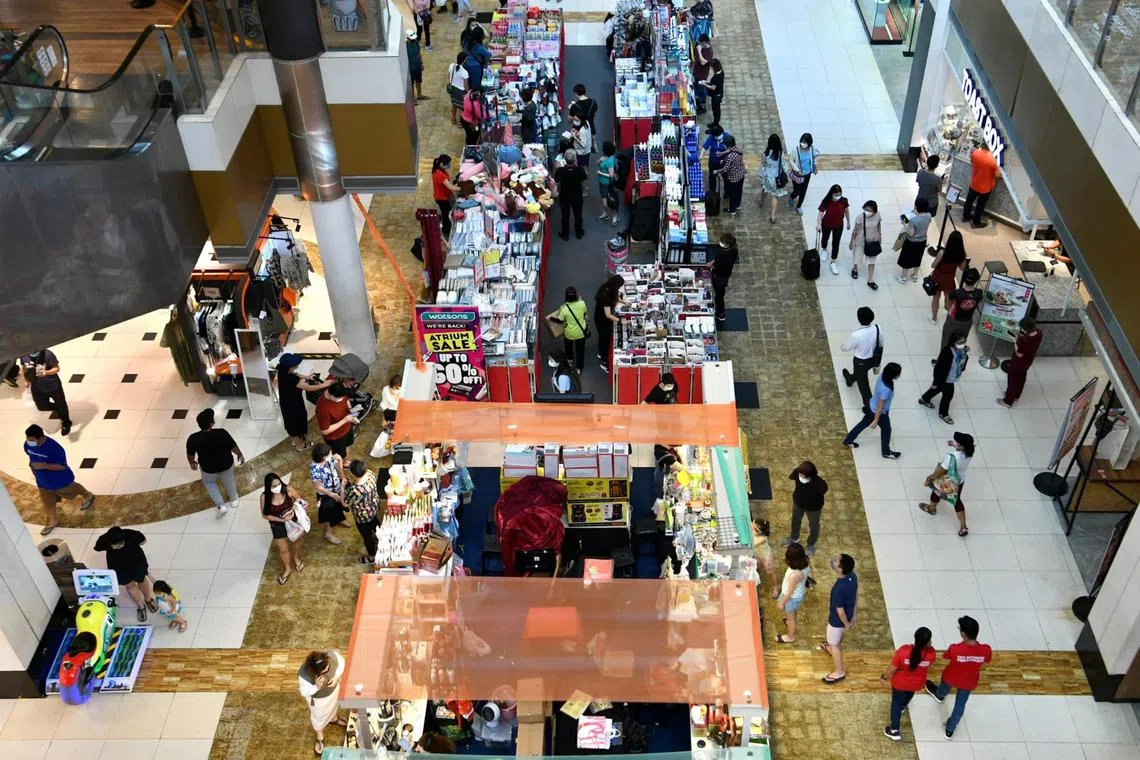Singapore retail sales fall worse-than-expected 3.6% in February; tariffs darken outlook
Sign up now: Get ST's newsletters delivered to your inbox

The drop in sales in Singapore was worse than the 0.2 per cent dip forecast by analysts in a Bloomberg poll.
PHOTO: ST FILE
Follow topic:
SINGAPORE – Retail sales in Singapore fell more than expected in February, with analysts expecting negative fallout ahead from the latest US tariffs announced this week.
The impact on Singapore’s economy from the Trump administration’s sweeping tariffs
DBS Bank senior economist Chua Han Teng said: “Escalating global trade tensions could negatively impact Singapore’s small and open economy, potentially softening employment conditions and consumer confidence, and weigh on household spending and retail sales.”
Data from the Singapore Department of Statistics (SingStat) on April 4 showed retail sales slipped 3.6 per cent year on year in February – partly due to the timing of Chinese New Year.
It comes after retail sales rose 4.5 per cent in January
“The decline in retail sales was partly due to Chinese New Year being celebrated in February last year, as opposed to January this year,” SingStat said.
Still, February’s drop was much worse than the 0.2 per cent dip forecast by analysts in a Bloomberg poll.
Excluding motor vehicles, retail sales fell by a sharper 6.7 per cent year on year, reversing the 4.8 per cent increase in January.
When the Chinese New Year effect is stripped out, retail sales in the first two months of 2025 edged up 0.8 per cent, thanks to car sales.
Excluding motor vehicles, sales contracted by a smaller 0.5 per cent in January and February compared with 2024.
“The decline in total retail sales in January to February (when car sales are excluded) suggests that domestic consumption remains subdued,” said Maybank Securities Singapore economist Brian Lee.
“The spending boost from the $300 CDC vouchers given to each household in January has been short-lived.”
He added that retail sales are likely to remain subdued this year.
“Consumer demand is being diverted overseas with the strong Singdollar. Household sentiment could weaken amid a dimming economic outlook and broadening global trade war.
“High manpower and rental costs continue to weigh on operating margins,” said Mr Lee.
OCBC Bank’s chief economist and head of global markets research and strategy, Ms Selena Ling, said that US President Donald Trump’s latest round of tariffs will add to the “risk-off mood” due to the heightened uncertainties, referring to a situation where market sentiment is more cautious, and the appetite for risk is lower.
Economists said Mr Trump’s tariffs may not necessarily lead to higher retail prices here.
Ms Ling said that deflationary effects, or decreasing price levels, are more likely as the economies hit by the tariffs see dampened domestic demand and growth.
Maybank’s Mr Lee said: “The net effect of Trump’s tariff war should be disinflationary, due to slowing global demand and a global glut of goods displaced by high US tariff walls.”
In February, the biggest year-on-year decline in sales was for apparel and footwear (18.4 per cent), followed by department stores (14.6 per cent), and supermarkets and hypermarkets (13.3 per cent).
Takings at the till rose year on year for other categories such as motor vehicles (20 per cent), optical goods and books (6.4 per cent), and computer and telecommunications equipment (4.3 per cent).
Sales of food and beverage services fell 5.6 per cent year on year in February, reversing the 10.3 per cent jump in January. SingStat also attributed the lower F&B sales to the Chinese New Year timing.
On a seasonally adjusted month-on-month basis, F&B sales dropped 1.4 per cent from January, reversing from the 4.9 per cent growth in the previous month.
The total F&B sales value came in at $961 million in February, lower than the $1.1 billion for the prior month.
About 23.4 per cent of the total came from online sales.
Restaurant turnover declined 10.2 per cent year on year and sales from fast-food outlets fell 8.2 per cent. Cafes, foodcourts and other eating places also saw turnover drop 3.1 per cent.
In contrast, food catering revenue climbed 6.6 per cent year on year.

